"An Inconvenient Sequel" director Bonni Cohen explains what it means to be inconvenient in the face of climate change
Al Gore, former Vice President of the United States and Democratic nominee for president, first used his political influence to document the reality of climate change in 2006, with the film An Inconvenient Truth. More than ten years later, environmentalists are still fighting to prove the existence of climate change and its horrific impact on our planet, despite the vast majority of scientists having reached a consensus that global warming is happening. President Donald Trump plans to withdraw the U.S. from the Paris Climate Accord, each year has been hotter than the last, glaciers are melting, and American city streets are flooding.
That’s why Al Gore has returned with another documentary detailing what has continued to destroy our planet — and how we can fight back — with An Inconvenient Sequel: Truth to Power. Directed by Bonni Cohen and Jon Shenk, a married filmmaking team, the film once again follows Al Gore, a “recovering politician.” We see Gore travel across the globe, educating people about climate change, training everyday people to become climate reality leaders in his seminars, and trying to awaken politicians to the fact that climate change is not a partisan issue.
Watching An Inconvenient Sequel is sobering, heartbreaking, and empowering at the same time, driving home the fact that stopping climate change means “being inconvenient” and speaking truth to power. We had the opportunity to speak with co-director Bonni Cohen, who also co-directed Audrie & Daisy and Inside Guantanamo. Cohen talked to us about working with Al Gore in the era of Trump, witnessing the impact of climate change so closely, and the importance of women’s perspectives guiding social justice conversations.
HelloGiggles (HG): The documentary’s timeline follows events before Donald Trump was elected, during the 2016 presidential election, and after. What was it like to follow Al Gore during this time in politics?
Bonni Cohen (BC): We were filming most of this during the presidential election year, 2016. We started in 2015 and then went all the way through to the election…Al Gore is kind of in a post-political moment in his life. He’s not a politician anymore, but he obviously cares a lot about politics and we often had the news media playing in the background of scenes that we were capturing with him. We felt like that would be a great way to keep the audience updated on the background noise of the political campaign. You know, there was a Republican field of 17 candidates in the beginning, none of whom had a position on the climate crisis.
It was really frustrating to watch, and Al Gore was quite frustrated by that. I don’t think any of us really knew that it was possible for Donald Trump to win, although Al kept suggesting that it was going to be a possibility. Then when it happened, we realized that most of the film really did not need to change because the film is about Al Gore. We were filming him during a very specific moment in time in the run-up to the Paris Climate Conference. And as politics, while they do play a role, they shouldn’t be trumpeted too loud in the case of climate because we really feel the climate crisis is not meant to be a partisan issue. It’s an existential issue for all of us, and we need to get over it as a partisan issue. So, while we have to acknowledge the devastation of the Trump administration vis-à-vis climate, we can’t give it too strong a voice in the film because there is so much wonderful work that is going on to solve the crisis.
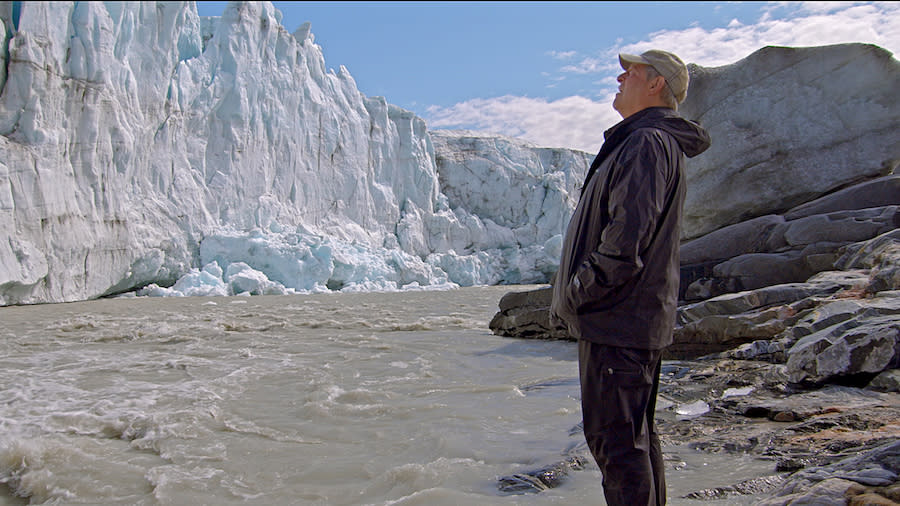
HG: A lot of people dismiss climate change despite overwhelming scientific evidence — and many people dismiss media about climate change as propaganda. We’re wondering, how did you reconcile that in your work on this film?
BC: Toward the end of the film, you hear Al Gore give this impassioned speech about how this movement is much in line with the other social movements of our time. The civil rights movement, the women’s suffrage movement, gay rights, etc., and that’s really true now. This issue has become much more emotional for people as they…Ya know, you used to not see much of your life changing as a result of the climate crisis. Now, weather patterns are so different. Farmers don’t recognize weather in order to grow their crops and their livestock. Fisherman are having a very difficult time with the warming seas.
So constituencies, communities around the country, are speaking out to their legislators as the climate crisis starts to affect their daily lives. So that’s new…This has become very emotional for people now. It’s probably going to be the existential crisis of our time, I would say. And all those social movements in the past were out to speak the truth, and bring the truth, stick by the truth at whatever cost, and eventually we’ll turn the needle. And that’s true here as well.
If you put the truth forward with conviction and continue to do so, the movement is going to galvanize more support. Because you can’t hide the truth. You can’t hide from the truth.
HG: Was there something new that you learned about climate change while you were filming this?
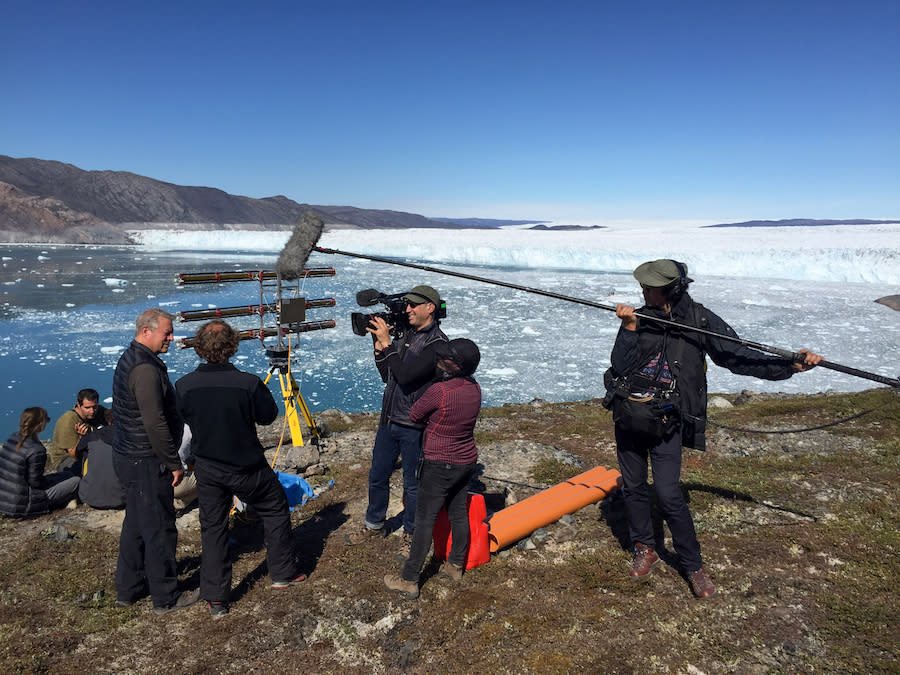
BC: So many things. I don’t even know where to begin…You know, when we were trying to figure out how to make the film and how to make it different from the first film, which was such a huge moment in both explaining global warming to the world for the first time and in terms of success of the film. And we thought about what to do with the sequel when [media company] Participant brought it to us.
John and I had made one climate film prior to this called The Island President, so we thought about this before. But the truth is, what is so easy to do with the climate crisis is to hold it at arm’s length and say to yourself, “I’ll deal with this tomorrow. And maybe when the effects happen, we’ll all be dead anyway so we don’t really have to worry about it. Let’s just keep getting in our trucks and burning fossil fuel.”
But what we learned…John and I are parents of two teenagers, and when we started to look at the climate crisis through their eyes, and what we were leaving them and looking at the horror on their faces when they were hearing the science and seeing Al Gore’s slideshow, what we realized is we need to act now. That’s the most important thing we learned about the climate crisis. Not that we weren’t environmentalists going in, but even we as progressive thinkers [who are] on board with the science, we would tell ourselves a story when we woke up every morning about, “We’re doing some, but maybe we’re not doing enough.” But it was more a philosophical take on the crisis. Now, I think we feel like we really know we’re in a place where we have to act and we’re trying to do something every day to chip away at it.
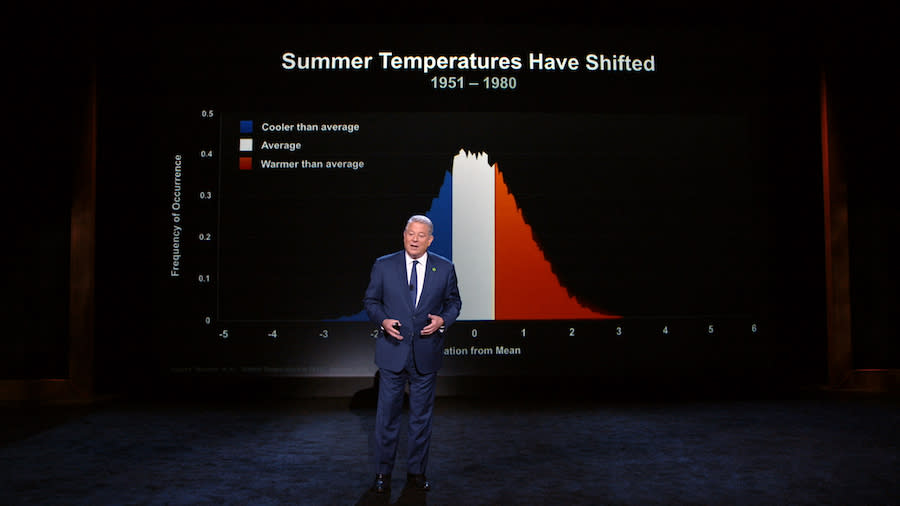
HG: If there was something short you could say to people who don’t believe climate change is real, with all of the knowledge that you’ve acquired and that is publicly available, what would you say to them?
BC: I would say that you go out and you buy life insurance and homeowner’s insurance, and your house probably won’t burn down. You probably won’t get into a car crash, but you take out an insurance policy in order to make sure that you’re taken care of in case something happens.
So even if you believe there’s a 2% chance that maybe the climate scientists are right and what Al Gore has been saying for the last 40 years is right, why not take out an insurance policy on that and get on board and make sure that we’ve got clean air to deliver to our children and grandchildren?
HG: What is one directorial choice you made that you’re especially proud of? One that helped make the film as impactful as it is?
BC: I feel like we made a decision early on about what people were kind of expecting, i.e., “Oh, we’re gonna see another film about Al Gore. So we’re probably gonna see his slideshow.” And people know what that’s going be.
So, ya know, what we wanted to do directorially is create these portals where, if you were hearing something in the slideshow, we would be able to take the viewer to that place and make it…As an example, Al’s talking on stage about Greenland and, all the sudden, you’re in Greenland. And you’re talking to scientists that he gets to talk to…and you’re down in the nitty-gritty of the work and the discovery.
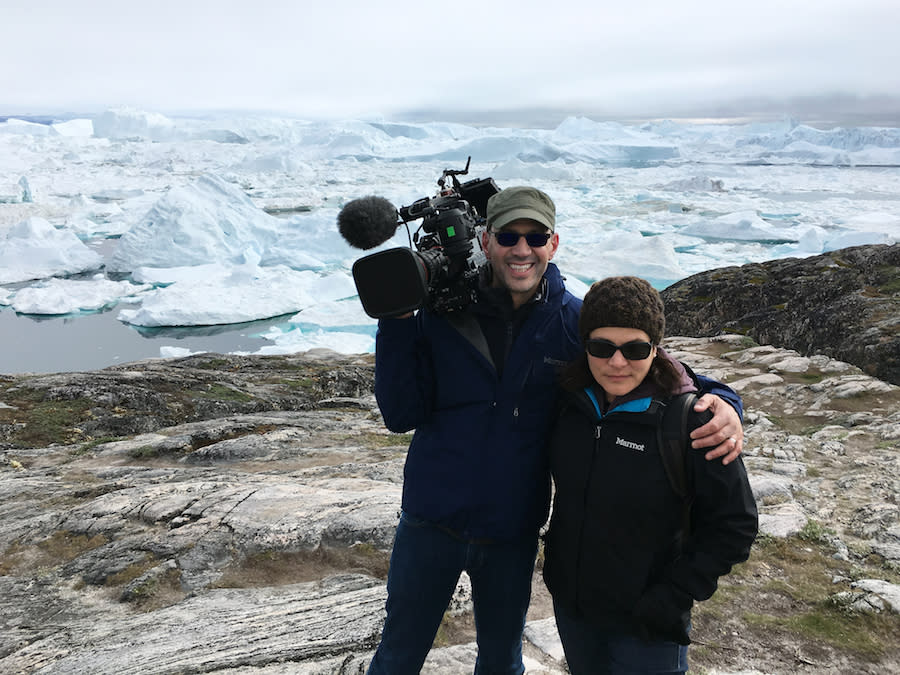
I feel very proud of that. I feel like we take people to unexpected places and, hopefully, with the beauty of the earth and the beauty of the cinematography mixed with the devastation, you are unable to leave the film not feeling emotionally charged by this.
For example, if you’re looking at the glaciers explode in Greenland and in the next minute you’re seeing how exploding glaciers result in the floods on the streets of Miami Beach, that brings it home for people. Those kinds of images that we made, I think, are somewhat unique in terms of driving the climate crisis home for people, emotionally.
HG: What was it like to meet the climate leaders at those trainings we see in the film?
BC: It’s so interesting. There were so many people who we met around the world who had changed their lives because they had seen An Inconvenient Truth in 2006. Climate leaders that we met in Paris at the climate conference, including the woman who was running the entire climate conference, Christiana Figueres, who had gone through Al’s training program in 2007.
We met those who had turned their lives around, having done the training years ago, and it was really cool to see the climate work that they were doing. In terms of the ones who were showing up, they were very eager to learn depending on where we were in the world. For example, the trainees that were in the Philippines, which was still recovering from the incredibly devastating typhoon that had hit the city of Tacloban there. The people at the training were, in some cases, climate refugees or people who had lost a lot of family members or friends to this devastating climate-related weather event. So, that was very emotional.
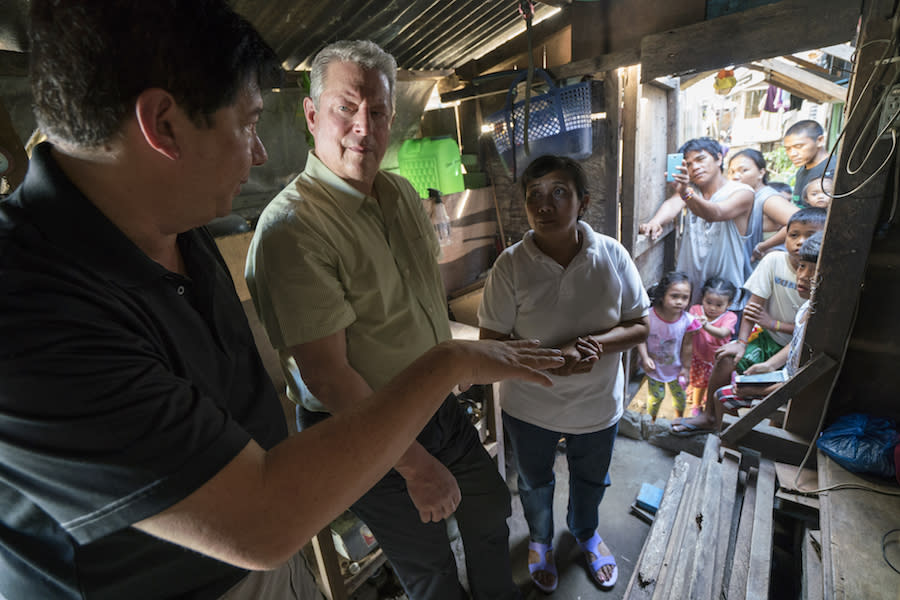
They were there to learn how they could step up. They’re on the front lines of this and how could they step up, learn about the climate crisis, and get involved in teaching it? In that regard, the climate trainings are sort of like…they have a little bit of a church aspect. Al is the minister and he’s proselytizing on a certain level, but there are people there to learn, and to learn on both an emotional and a factual level, so that they can make the decisions in their own lives going forward.
HG: Is there a specific memory from when you were filming that stands out to you, that encapsulates your whole experience with this documentary?
BC: There were so many amazing experiences. I would say that standing on the foot of the Jakobshavn glacier in Greenland with Al Gore, a man who’s spent 40 years battling the climate crisis, and watching the ice halve off the side of those glaciers and run out to sea. Is was a simultaneously beautiful and devastating moment. And that encapsulates the film. It has so much beauty and so much to be hopeful for, but we messed up and we need to turn this around.
HG: We know that you’re only one of seven women directing a film from a major studio this year. What can other people in film do to improve those numbers?
BC: I mean, a woman’s perspective on social issues is wholly invaluable. John and I would go out into the field with Al Gore and we would often have very different perspectives on how to capture a scene or on what was important. I feel like, as not just as a woman, but as a mother, these kinds of issues — whether it’s the climate crisis, whether it’s Black Lives Matter, whether it’s abortion, whether it’s health care — there’s nothing to replace a woman’s perspective. And if we want to reach populations in this country and around the world with stories that matter, you just have to take more women on board because those are the perspectives that we care about.
If we don't step up, no one will. #BeInconvenient🌎 pic.twitter.com/3k1lO3VEmi
— AnInconvenientTruth (@aitruthfilm) June 22, 2017
HG: For you, personally, what does it mean to be inconvenient?
BC: To be inconvenient means to step outside of the comfortable skin of your normal life and do something that makes you a little bit uncomfortable in order to make change. It doesn’t have to be a huge thing. It can be something small, but something that you do consistently, every day, that makes you feel the discomfort of the change you’re trying to make.

